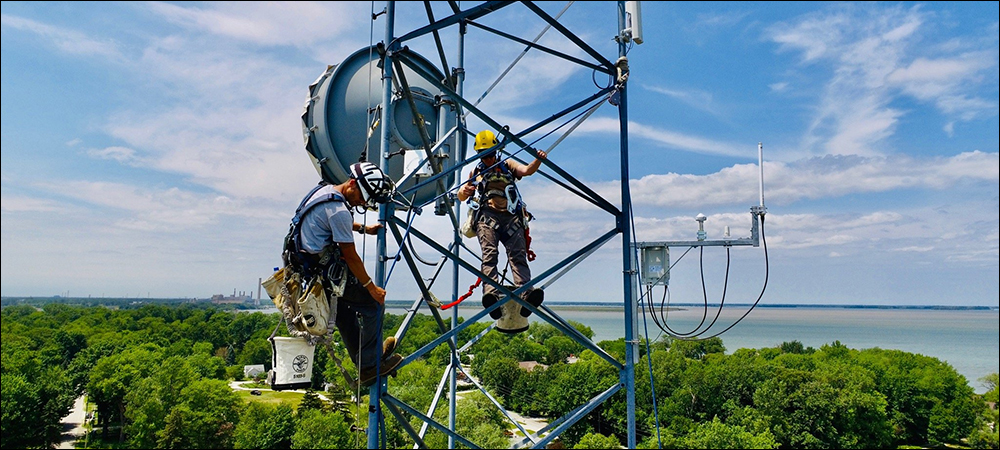- Tracking Algae Blooms with Long-Range Connectivity
- Gateway Provides 17-Mile Read Range
- Dispersing Hundreds of Sensors in Watershed
Lake Erie provides drinking water for approximately 11 million people living along its shores. This year, an Internet of Things (IoT) technology-based solution is being tested to track the conditions of that water via low-power, long-range wide-area network (LoRaWAN)-based sensors deployed on buoys and along the Ohio-side lake watershed. The Cleveland Water Alliance (CWA) is testing the LoRaWAN solution to collect and manage sensor-based data regarding vulnerable waterways in the area surrounding Lake Erie.
Freeboard Technology, a new spinoff of environmental science consulting company LimnoTech, has been piloting the technology as part of CWA’s Smart Lake Erie Watershed initiative, a state and federally funded program to better monitor and manage area waterways. The initiative is intended not only to ensure clean, healthy water, but also to provide business opportunities aimed at accelerating water technology development.
Excessive algal growth in Lake Erie poses a threat to human health, as well as to the ecosystem. Algae can persist for weeks during summer months, due to blooms being carried by winds and currents eastward through the lake. In fact, algal blooms have reached read-breaking levels in recent years, as have dead zones, which are oxygen-depleted areas caused when algae die and decompose.

Excessive algal growth in Lake Erie poses a threat to human health, as well as to the ecosystem.
Tracking Algae Blooms with Long-Range Connectivity
One way to track those blooms is via sensors, and LimnoTech has been providing a service to do so for several years with existing technologies. Placing sensors in and around offshore water intakes has depended on wireless networks for data collection, according to Ed Verhamme, a LimnoTech principal and Freeboard Technology’s president. However, he says, “We’ve often run into this challenge of no cellular coverage and we’ve made do, as we could, with range extenders or special antennas.” In some cases, the company also used Iridium satellite data.
At the same time, businesses and organizations have been seeking more data from waterways that would continue to challenge the limits of existing wireless networks, especially for offshore connectivity. Last year, LimnoTech launched Freeboard to bring connectivity to areas where it was unavailable. As a subsidiary, Freeboard is leveraging LoRaWAN connectivity, with the network back end provided by Senet, using off-the-shelf and custom sensors that transmit data to a server via a gateway installed by Freeboard. The network could serve as a low-cost way to capture data, the company reports, and to then share availability of the network and its data with other enterprises.
LoRaWAN is an open-source, wireless protocol that allows battery-operated devices to send small packets of data at a far longer range than is possible with Wi-Fi or Bluetooth, at a cost less than with cellular connections. Freeboard is attaching battery-powered sensors to buoys and installing them on land, to capture and transmit water condition data. Initially, the focus is on measuring algae levels, while in the long term such sensor networks could be employed to identify and measure toxic algal blooms, chemical spills, urban flooding and other applications. Thus far, Verhamme says, Freeboard has installed 10 LoRaWAN gateways at locations between Toledo and Cleveland.

The Cleveland Water Alliance is testing LoRaWAN technology to collect and manage sensor-based data regarding vulnerable waterways in the area surrounding Lake Erie.
Gateway Provides 17-Mile Read Range
Using Senet’s planning tools, Verhamme says, Freeboard identified suitable locations for the gateway on the lake shore. The sensor deployments commenced in the Cleveland area in August of this year, while additional gateway installations are planned along the Ohio shoreline and in other key inland and urban areas across northern Ohio. Freeboard is providing regular connections to areas where cellular coverage isn’t available, including buoys located 17 miles from shore.
Sensors measure algae levels near where water is in-taken from the lake to be processed for drinking. Sensors can be programmed to periodically transmit data to the gateway, which in turn forwards measurement information to LimnoTech’s software, hosted on its server. The company shares that data as a service with the Cleveland Water Alliance and other clients. The information enables CWA to view, in real time, when conditions become unsafe, such as if an algal bloom is detected and measured at an unsafe level. Additionally, the data can be used for historical purposes, to track the conditions over time and connect measurements with weather or other external factors.

Ed Verhamme
Because LoRaWAN-based sensors are relatively affordable, Verhamme says, Freeboard has been deploying dozens of them not only for the CWA but also for use in the future by groups that manage sewage or watershed health and safety. “Lake Erie is impacted by urban runoff, as well as agricultural runoff,” he states, so the technology is intended to help parties track these runoff sources and thereby better “understand the science behind the delivery of all these sediments and nutrients to the lake.”
LoRaWAN sensors can transmit at long range and are relatively low in cost. As such, Verhamme notes, “We’re able to start putting more sensors not only on the lake but up into the watersheds for tracking these pollution sources.” Freeboard Technology serves as a data-as-a-service provider. The company is responsible for installation and maintenance of all the devices, while its customers pay for access to and analysis of the collected data.
One challenge for Freeboard as it offers its solution to new customers is to educate potential buyers on LoRaWAN, which remains a relatively little-known technology. Most people still think of cellular and Wi-Fi connectivity as the main options for wireless coverage, Verhamme says. “So we’re having a lot of people observe us building out this network,” he states. “We show them its capability and functionality,” as sensors transmit data without requiring cellular infrastructure.
Dispersing Hundreds of Sensors in Watershed
Senet says it operates the largest, most densely deployed public, carrier-grade LoRaWAN network in the United States. The Freeboard deployment is an example of Senet’s strategy to build out a nationwide IT network, says Bruce Chatterley, Senet’s CEO and president. The IoT services are launching in regions around the nation, usually driven by the needs of a utility or governmental agency, such as a city’s department of health.
Once the network is in place, with gateways installed that receive transmissions from area sensors, the Senet-based network can become public. Users can then access the network to send data, after they have signed up for a subscription service. Senet thus offers its Low Power Wide Area Virtual Network (LVN), which connects a network operator with an application provider under a cooperative model for roaming contracts. That means other users of the network Freeboard has established could set up a contract with Senet, with 50 percent of the revenue going to Freeboard as an LVN partner.
“We’ve been really starting to get a lot of momentum with that strategy,” Chatterley reports, with individual networks deploying across North America. In regions that lack LoRaWAN coverage, he adds, Senet’s strategy is to support companies or organizations that identify an application and its unique requirements for both propagation coverage and signal strength. The company then builds the network, which can subsequently be used for other applications. “I think government is becoming a catalyst to drive this kind of network deployment,” he states.
In the future, Freeboard Technology foresees a variety of applications for its solution. The company plans to offer the technology for more than just monitoring water toxicity. For instance, it could provide location services to track sensor movements in one of the Great Lakes, enabling it to understand water currents. The company would also like to test LoRaWAN receiver nodes on ships transiting the lakes. “We’re going to be identifying partners and grants to go beyond the Ohio waters of Lake Erie,” Verhamme says. “We don’t see the algal bloom issue going away.”
Key Takeaways:
- Freeboard Technology is piloting a solution using LoRaWAN infrastructure to monitor water quality in and around Lake Erie for the Cleveland Water Alliance.
- In the long run, this same network can be used for other environmental measurements by Freeboard or other entities requiring low-cost IoT data.


